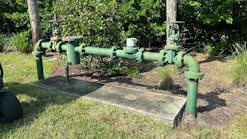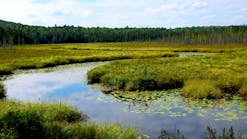It might seem premature to talk about deicing salt in the middle of July, but that’s just what public works departments in northern climes are doing right about now, planning strategies to limit its use come winter.
Road salt is essential for drivers’ safety in many climates, and there’s no question of it being eliminated entirely any time soon. For years, though, its corrosive properties have aggravated engineers and highway workers; it’s tough on pavement and on the steel used to reinforce concrete in bridges—not to mention on cars. More recently, we’ve realized that it’s having an effect on the salinity and the ecosystems of our surface waters.
Each year, approximately 15 million tons of deicing salt is used in the US, and another 4 to 5 million tons in Canada. Because chloride ions are stable and don’t easily break down, just about all of the chloride that goes onto the roads ends up eventually in surface waters. BMPs that remove other pollutants–total suspended solids, nutrients—don’t remove salt.
In some places—Minnesota’s Shingle Creek Watershed, for example, northwest of Minneapolis—the chloride concentrations are so high that total maximum daily loads are being developed. There are two main angles of attack: looking for safer deicing materials that work as well as the old ones, and limiting the amount that’s applied to the roads.
The second part is easier to achieve in many cases. Training equipment operators on how much salt to apply based on road conditions, and ensuring that the equipment itself is well calibrated to dispense the correct amount of salt, can go a long way toward eliminating waste. Near Minneapolis, sensors embedded in the roadways help determine optimal application rates. In Wisconsin, weather stations along the highways and temperature sensors on maintenance vehicles allow public works officials to make more informed decisions about how much salt to apply. Even storage can make a big difference: Lancaster, OH, is considering using part of its federal stimulus funding to build a new “salt barn”—a storage area for road salt—to replace its leaky existing one, which is located next to a creek.
Investigations into alternative materials are ongoing, but such substances also have their drawbacks. Some calcium- and magnesium-based products are being used; they still contain chloride, just not as much of it, and they are expensive. Organic materials, such as substances derived from beet juice, have also been tried. A concern with any organic-based deicer, though, is that it might add phosphorus to the system, substituting one water-quality problem for another. Sand is often used as well, although it doesn’t lower the freezing point of water the way salt does, and in large enough quantities it leads to sedimentation of lakes and rivers.Janice Kaspersen
Janice Kaspersen is the former editor of Erosion Control and Stormwater magazines.





